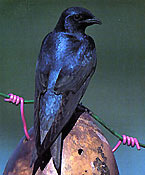 | Greenville business & community directory | |
|
This is an archived page that may contain outdated or incorrect information. Please visit www.Greenville.com for the latest news, events, and more.
 Now is the time to put up gourds and houses for purple martins, the only bird species in eastern North America totally dependent on humans for nest cavities.
Now is the time to put up gourds and houses for purple martins, the only bird species in eastern North America totally dependent on humans for nest cavities.
"Purple martins are accustomed to humans and seem to prefer nesting close to man," said Laurel Barnhill, wildlife biologist and statewide bird conservation coordinator with the S.C. Department of Natural Resources (DNR). "In fact, martins have a long list of desirable habits. They nest in colonies and have fascinating social behavior, their vocalizations are beautiful, and they are extremely graceful and acrobatic in flight." Although purple martins migrate to South America for the winter, Barnhill said they remain faithful to their colony sites from one summer to the next, often returning about the same date each year. Since some martins arrive as early as mid-February, there is no time to waste before putting up purple martin gourds and houses. Native Americans were enticing purple martins to nest within their villages centuries before the Europeans settled here. Indians suspended hollowed-out gourds from their dwellings to attract the birds, and the early settlers later adopted this custom. While martins once nested in old woodpecker cavities and hollow trees, in the eastern United States they are now entirely dependent upon man for nesting sites. Purple martins are voracious insect eaters. And although martins do not consume large numbers of mosquitoes, as do several species of bat that patrol the sky during nighttime hours when mosquitoes are most active, martins nevertheless prey on many noxious insects such as flies, wasps, beetles, stinkbugs and leafhoppers. Purple martin gourds or houses should be in place for breeding birds by mid-March, Barnhill said. However, houses and gourds can be put up through the summer, since non-breeding martins and sub-adult birds, and even late-summer migrants, may find these houses and return to nest in them the following year. The martin houses should be on poles 12 to 15 feet high in open locations away from trees, in habitats such as those found on golf courses, school grounds, orchards or agricultural fields. In general, no trees or buildings should be within about 40 feet of the martin pole in any direction. Most people living in town will not be able to attract martins because of too many trees and obstructions, Barnhill said, but pond shore lines and marinas provide excellent martin nesting sites. "Get started with a few natural gourds, or buy plastic ones," Barnhill said. "They are less expensive than houses, and they can be attached to a line strung between two points." Keep the martin gourds or houses cleaned out after the nesting season, and discourage house sparrows and starlings by removing nest material. When using natural gourds, in addition to making an entrance hole with a diameter of 2 1/8 inches, drill a few small holes in the bottom of the gourd to keep rainwater from accumulating. To receive more information on purple martins and martin gourd house plans, call the Purple Martin Conservation Association in Edinboro, Pa., at (814) 734-4420 or send an e-mail to pmca@edinboro.ed. DNR protects and manages South Carolina's natural resources by making wise and balanced decisions for the benefit of the state's natural resources and its people. (Image provided by the Department of Natural Resources.)
|
